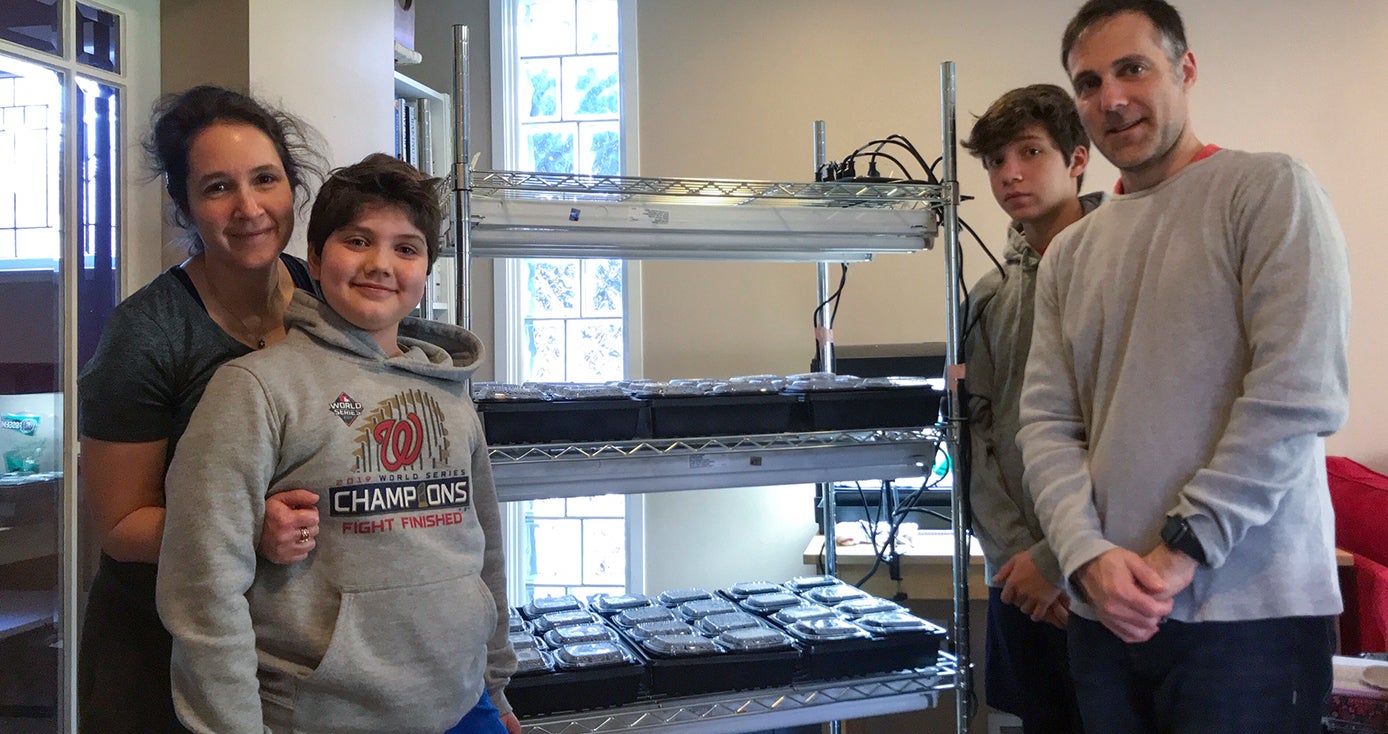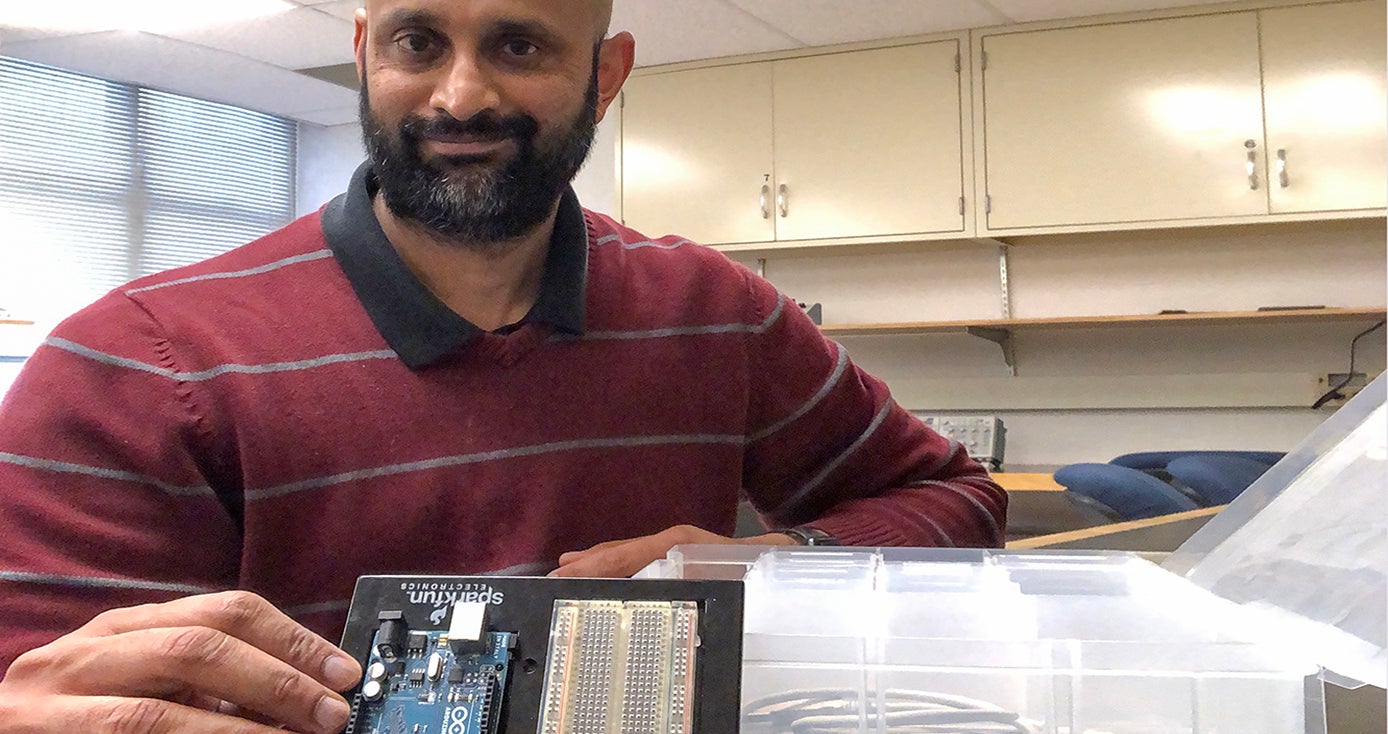
Subscribe to Pittwire Today
Get the most interesting and important stories from the University of Pittsburgh.Science Instructors Find Ways to Bring the Lab to Their Students
When Nancy Kaufmann, a senior lecturer in the Department of Biological Sciences in the Kenneth P. Dietrich School of Arts and Sciences, learned classes would be transferred online due to the COVID-19 outbreak, her mind immediately went to duckweed.
Her introductory research lab, called Duckweed Survivor, requires hands-on experiments with duckweed samples floating in pond water that an undergraduate researcher in the Turcotte Lab of Evolutionary Ecology had collected from ponds around Pittsburgh and Pymatuming the previous semester. Information from student samples is applied to a larger data set that supports research in the lab. How could that possibly go digital?
Ultimately, it took 80 plastic takeout containers, 16 hours of artificial light per day, Zoom lectures and biweekly smartphone photo shoots to pull off from Kaufmann’s home. Getting the whole setup to her house required her husband Brian’s help driving the containers safely across the Oakland neighborhood, with her 15-year-old son, Toby, pushing the wire rack holding the experiments up the length of Forbes Avenue.
In the scramble to bring lab instruction to students hunkered down indoors across the globe, professors with hands-on courses adopted strategies ranging from shipping equipment and tools directly to students to stretching remote learning technologies farther than ever before.
For some courses at Pitt, such as the Foundations of Biology SEA-PHAGES Laboratory 2, which teaches students to discover, isolate and characterize unique viruses through a combination of field, lab and computational experiments, the timing was just fortunate enough to allow the previous semester’s work to continue uninterrupted. Eberly Family Professor of Biotechnology Graham Hatfull’s lab is the sponsoring science research lab for the course, which is taught at more than 100 schools nationwide and overseen by the Science Education Alliance at the Howard Hughes Medical Institute.
“Thankfully, we were in the best position to go online because it’s a bioinformatics course,” said lecturer Kristen Butela, who is coordinator of the SEA-PHAGES program. “We did have some wet bench experiments with students still working on their bacteriophages from last semester, but through a complete accident of timing, we wrapped up those experiments a week before break.” (Spring break began on March 8; classes resumed, after an extra week for instructors to prepare, on March 23.)
In the Department of Physics and Astronomy‘s Introduction to Laboratory Physics course, graduate student instructor Daniel Doucette had already been working on a less structured classroom format and research designed to promote independent student experiments before semester break. Coincidentally, before the outbreak, physics instructors around the world had been thinking along similar lines and had created a series of simulation programs that allowed students to conduct experiments on virtual electrical circuits.
“On the screen, you can have a circuit diagram and you can flip the switches, or you can move virtual ohm meters, volt meters and ammeters as if it were the real thing sitting in front of you. It’s about as close as you can get to the real thing without having it there,” said Doucette.
But for the more advanced Analog and Digital Electronics course, the timing wasn’t as ideal. Gurudev Dutt, associate professor of physics and astronomy, said the course is crucial for juniors and seniors who will take skills learned in the lab to the workforce in the next few years.
Before spring break, students had just wrapped up work with analog electronics and were poised to learn how to work new digital electronics equipment when they returned to campus. When Dutt realized campus would close, he worked with department officials to obtain 24 Arduino Microcontrollers, which feature programmable circuit boards and computer software, to ship to students at their residences.
“You can connect a temperature sensor, a pressure sensor, an optical sensor. You can connect motors. Microcontrollers are great for handling tasks that require a specific hardware interface or digital or analog signal. The computer can program the microcontroller to handle that task then the microcontroller keeps running and doing its job,” said Dutt.
Under normal circumstances, students would be expected to complete experiments that use the microcontroller’s sensors and temperature detection components. However, the kits that were shipped to students were stripped down to the most basic functions because equipment that would have supplemented experiments in the lab was too expensive to send. Because of the constraints, Dutt said he expects students’ final projects to be stripped down as well.
“Some of the special projects have specialized components. We have motors to control wheels, LCD displays. The last time I taught this class, a student built an app to text a message to the Arduino Microcontroller and display it on the LCD display. At that point in the class it’s the student’s own imagination and creativity about what they want to do. We have a variety of equipment to enable that and, obviously, they’re going to miss out on all that,” he said.
And while students and instructors miss the physical spaces they shared last semester, many are still thankful the virtual space allowed for the opportunity to connect and educate.
“We need to find ways to still be interacting with other people,” said Kaufmann. “The main thing is to have some structure to courses and for students to have opportunities to be in communication with us and other students so they don’t feel as isolated as they would have otherwise felt.”



